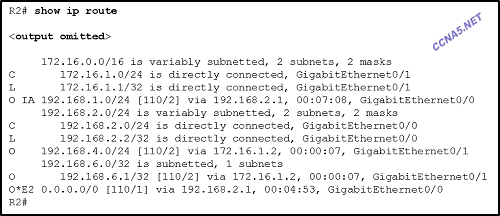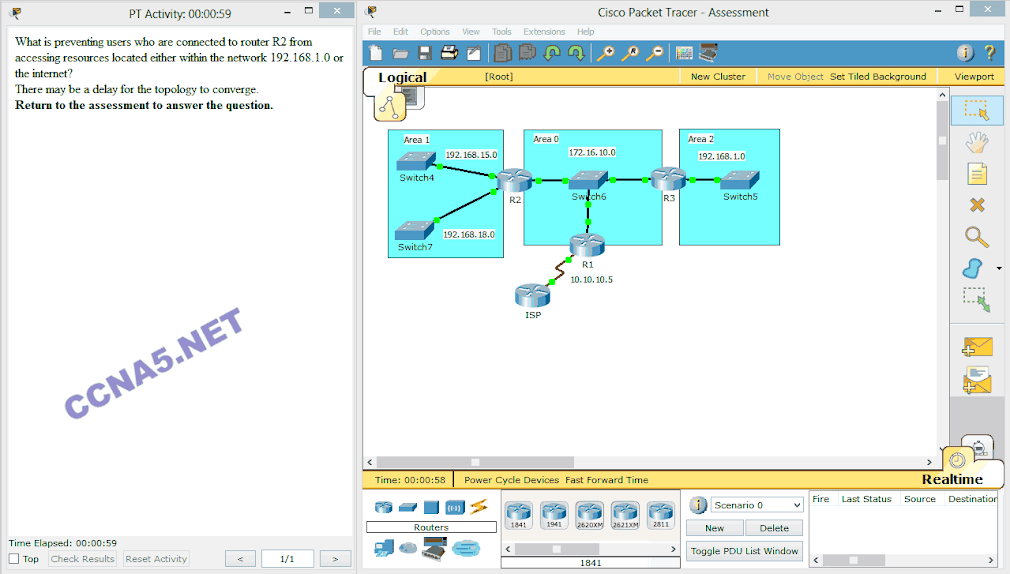0 of 21 questions completed Questions:
You have already completed the quiz before. Hence you can not start it again.
Quiz is loading...
You must sign in or sign up to start the quiz.
You have to finish following quiz, to start this quiz:
0 of 21 questions answered correctly
Your time:
Time has elapsed
You have reached 0 of 0 points, (0) The network administrator has been asked to summarize the routes for a new OSPF area. The networks to be summarized are 172.16.8.0, 172.16.10.0, and 172.16.12.0 with subnet masks of 255.255.255.0 for each network. Which command should the administrator use to forward the summary route for area 15 into area 0?
Fill in the blank. Fill in the blank. Do not use acronyms. What is one advantage of using multiarea OSPF?
A network administrator is verifying a multi-area OSPF configuration by checking the routing table on a router in area 1. The administrator notices a route to a network that is connected to a router in area 2. Which code appears in front of this route in the routing table within area 1?
An ABR in a multiarea OSPF network receives LSAs from its neighbor that identify the neighbor as an ASBR with learned external networks from the Internet. Which LSA type would the ABR send to other areas to identify the ASBR, so that internal traffic that is destined for the Internet will be sent through the ASBR?
Which three steps in the design and implementation of a multiarea OSPF network are considered planning steps? (Choose three.)
Fill in the blank. Use a number.
Which command can be used to verify the contents of the LSDB in an OSPF area?
Which statement describes a multiarea OSPF network?
Which characteristic describes both ABRs and ASBRs that are implemented in a multiarea OSPF network?
Where can interarea route summarization be performed in an OSPF network?
Launch PT Hide and Save PT
Which two statements correctly describe OSPF type 3 LSAs? (Choose two.)
A network administrator is implementing OSPF in a portion of the network and must ensure that only specific routes are advertised via OSPF. Which network statement would configure the OSPF process for networks 192.168.4.0, 192.168.5.0, 192.168.6.0, and 192.168.7.0, now located in the backbone area, and inject them into the OSPF domain?
Which two networks are part of the summary route 192.168.32.0/22? (Choose two.)
CCNA 3 Scaling Networks Chapter 6 v5.0 Exam
Quiz-summary
Information
CCNA 3 Scaling Networks Chapter 6 v5.0 Exam
Results
Average score
Your score
Categories
Pos.
Name
Entered on
Points
Result
Table is loading
No data available
1. Question
2 points
2. Question
3 points
3. Question
4 points

Sort elements
4. Question
3 points
5. Question
2 points
6. Question
2 points
7. Question
2 points

Refer to the exhibit. What can be concluded about network 192.168.4.0 in the R2 routing table?
8. Question
2 points
9. Question
3 points
10. Question
3 points
11. Question
2 points

Refer to the exhibit. What is indicated by the O IA in the router output?
12. Question
2 points
13. Question
2 points
14. Question
2 points
15. Question
2 points
16. Question
2 points

Refer to the exhibit. Which two statements are correct? (Choose two.)
17. Question
2 points

Open the PT Activity. Perform the tasks in the activity instructions and then answer the question.
What is preventing users who are connected to router R2 from accessing resources located either within the network 192.168.1.0 or the internet?
18. Question
2 points
19. Question
2 points
20. Question
2 points
21. Question
3 points

Refer to the exhibit. Fill in the blank. Do not use abbreviations.
CCNA 3 Scaling Networks Chapter 6 v5.0 Exam
CCNA 3 Scaling Networks Chapter 6 v5.0 Exam
CCNA 3 Scaling Networks Chapter 6 v5.0 Exam
